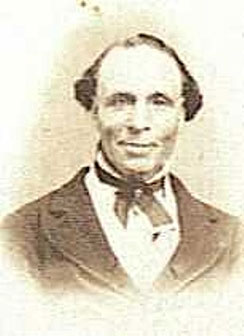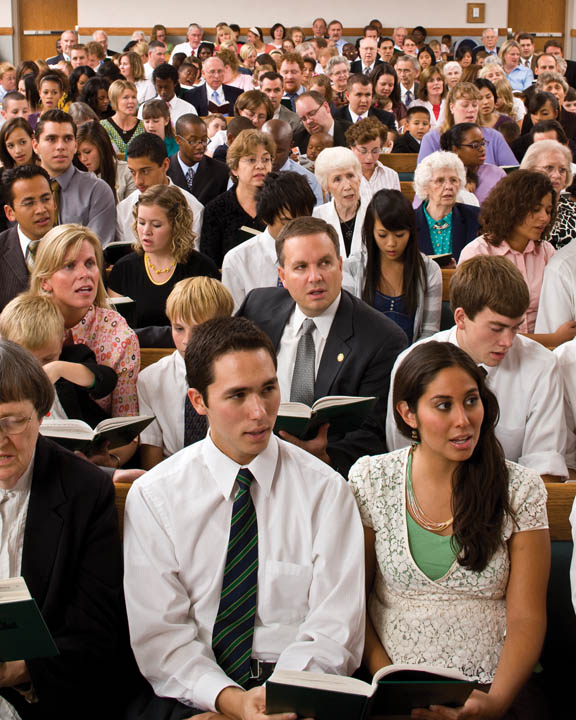Difference between revisions of "Black Mormon"
m |
m |
||
| Line 51: | Line 51: | ||
<videoflash>73JFl11Wxtw&rel=0</videoflash> | <videoflash>73JFl11Wxtw&rel=0</videoflash> | ||
| − | + | <br> | |
| + | |||
| + | |||
| + | |||
| + | <br> | ||
Read the official church history and explanation of Blacks and the Mormon priesthood [http://www.lds.org/topics/race-and-the-priesthood?lang=eng here.] | Read the official church history and explanation of Blacks and the Mormon priesthood [http://www.lds.org/topics/race-and-the-priesthood?lang=eng here.] | ||
| − | For more, go to [http://blacklds.org BlackLDS.org] | + | For more information, go to [http://blacklds.org BlackLDS.org] |
[[Category:Mormon Life and Culture]] | [[Category:Mormon Life and Culture]] | ||
[[es:Mormones negros]] | [[es:Mormones negros]] | ||
Revision as of 08:05, 18 February 2019
There have been Black members of The Church of Jesus Christ of Latter-day Saints since its founding. Mormon congregations have never been segregated (even though the Church was founded in 1830), and the early Latter-day Saints were anti-slavery. This increased the persecution against them, especially in Missouri, where many citizens wanted to enter the United States as a slave state. This especially increased when W.W. Phelps published a plan to bring free Blacks into Missouri. In fact, Missourians wrote the following:
- “In a late number of the Star, published in Independence by the leaders of the sect, there is an article inviting free Negroes and mulattoes from other states to become “Mormons,” and remove and settle among us.
In 1832 Elijah Abel was baptized into the Church and was later (1836) given the Priesthood. Abel served missions for the LDS Church in Ohio, New York, Canada, and elsewhere. In Nauvoo he was a member of the Quorum of Seventy. He went west to Utah in 1847 and helped to build the Salt Lake Temple. In Utah, He and his wife Mary Ann (also Black) managed the Farnham Hotel. He passed away in 1884. His son, Enoch Abel, was ordained an Elder. Enoch’s son, Elijah, was ordained a Priest on July 5, 1934, and an Elder on September 29, 1935.
In 1836, rules were published for the governing of the Kirtland Temple.
- The rules provided for “old or young, rich or poor, male or female, bond or free, black or white, believer or unbeliever…” (History of the Church 2: 368-69)
And the following in reference to the Nauvoo Temple:
- “If the work roll forth with the same rapidity it has heretofore done, we may soon expect to see flocking to this place, people from every land and from every nation, the polished European, the degraded Hottentot, and the shivering Laplander. Persons of all languages, and of every tongue, and of every color; who shall with us worship the Lord of Hosts in his holy temple, and offer up their orisons in his sanctuary.” (Times and Seasons, Vol. 1 No. 12 October, 1840. See also Latter-day Saints’ Millennial Star, Vol. 1, No. 9, January 1841 and in History of The Church of Jesus Christ of Latter-day Saints, Vol. 4)
Meanwhile, in 1841, as the Baptists argued that slavery was biblical, and others claimed that Blacks had no souls, Joseph Smith claimed that with opportunity equal to that of Whites, Blacks would perform as well as white people.
In 1844 a slave named Green Flake was baptized and remained faithful all his life. He was freed from slavery by Brigham Young and lived out his days in Idaho. That same year, Walker Lewis was ordained an Elder in the Mormon Church, and the prophet Joseph Smith ran for president of the United States on an anti-slavery platform. In 1846 William McCary was baptized and served in church leadership.
The Deseret constitution in Utah was amended February 4, 1867, to eliminate the words “free, white, male” from voting requirements by a vote of “14,000 for and 30 against.” (October 26, 1869, in Brigham Young papers, LDS Church Archives.)
In 1891 J. Golden Kimball received a telegram saying the Ku Klux Klan was going to tar and feather all of the Mormon elders in the county if they didn’t immediately leave. In 1895 the apostles of the Mormon Church tried to piece together the history of the priesthood ban that kept Blacks from being ordained to the priesthood. None had a first-hand experience to cite the beginning of the ban. Joseph F. Smith claimed that Joseph Smith meant for the Blacks to have the Priesthood, but then could not uphold Abel's ordination.
From time to time over the years, the General Authorities revisited the subject of Blacks and the priesthood, trying to determine who instituted the ban and why. They could not be certain whether the ban was brought about by revelation or due to social conditions. In 1940 J. Reuben Clark, Jr., recommended a committee be appointed to “make some ruling or re-affirm whatever ruling that has been made on this question in the past as to whether or not one drop of negro blood deprives a man of the right to receive the priesthood” (Council Meeting January 25, 1940, George Albert Smith Papers, LDS Church Archives). In 1949 a statement from the Church reaffirmed that Blacks may not have the priesthood, but in 1951 Under the direction of prophet David O. McKay, Melanesian blacks were defined as from a different linage and not under the priesthood ban. The first Figians received the priesthood in 1958, while the Negritos of the Philippines were given it earlier (Armand Mauss, Neither White nor Black, Signature Books, pg. 152).
In 1958, Joseph Fielding Smith made the following statement:
- “No church or other organization is more insistent than The Church of Jesus Christ of Latter-day Saints, that the Negroes should receive all the rights and privileges that can possibly be given to any other in the true sense of equality as declared in the Declaration of Independence. They should be equal to ‘life, liberty, and the pursuit of happiness.’ They should be equal in the matter of education. They should not be barred from obtaining knowledge and becoming proficient in any field of science, art or mechanical occupation. They should be free to choose any kind of employment, to go into business in any field they may choose and to make their lives as happy as it is possible without interference from white men, labor unions or from any other source. In their defense of these privileges the members of the Church will stand.” (Answers to Gospel Questions 2:185)
Smith goes on to say “if a Negro is baptized and remains true and loyal, he will enter the celestial kingdom [the highest kingdom of heaven].” But he also said, “but we cannot promise him that he will receive the priesthood.”
In 1953, Hugh B. Brown said, “we are in the midst of a survey looking toward the possibility of admitting Negroes” to the Priesthood. He said this in a New York Times article dated June 7, 1963. He also said the following:
- “During recent months, both in Salt Lake City and across the nation, considerable interest has been expressed in the position of The Church of Jesus Christ of Latter-day Saints on the matter of civil rights. We would like it to be known that there is in this Church no doctrine, belief, or practice that is intended to deny the enjoyment of full civil rights by any person regardless of race, color, or creed.
- “We say again, as we have said many times before, that we believe that all men are the children of the same God and that it is a moral evil for any person or group of persons to deny any human being the rights to gainful employment, to full educational opportunity, and to every privilege of citizenship, just as it is a moral evil to deny him the right to worship according to the dictates of his own conscience.
- “We have consistently and persistently upheld the Constitution of the United States, and as far as we are concerned this means upholding the constitutional rights of every citizen of the United States.
- “We call upon all men everywhere, both within and outside the Church, to commit themselves to the establishment of full civil equality for all of God’s children. Anything less than this defeats our high ideal of the brotherhood of man.”
In 1970 a Salt Lake Tribune article said, “President David O. Mckay of the Church of Jesus Christ of Latter-day Saints was quoted Wednesday as saying as early as 1954 that ‘There is no doctrine in this church and there never was a doctrine in this church to the effect that the Negroes are under any kind of a divine curse.’
On October 19, 1971, the Genesis Group was formed under the direction of Joseph Fielding Smith. Apostles Gordon B. Hinckley, Thomas S. Monson and Boyd K. Packer were assigned to meet with Ruffin Bridgeforth Jr., Darius Gray, and Eugene Orr to form the beginnings of the Genesis Group. The organization was to provide a fellowship group for black members in Salt Lake City as well as to try to activate other black Mormons who had gone inactive.
When Spencer W. Kimball became prophet of the Church, he said, “I am not sure that there will be a change, although there could be. We are under the dictates of our Heavenly Father, and this is not my policy or the Church’s policy. It is the policy of the Lord who has established it, and I know of no change, although we are subject to revelations of the Lord in case he should ever wish to make a change.”
On June 8, 1978 the revelation which gives the priesthood to everyone regardless of race or linage was announced. The events leading up to it and the revelation itself are judged to be a true miracle. Latter-day Saints everywhere rejoiced over the announcement that Blacks could hold the priesthood. Bruce R. McConkie said the following: "Forget everything I have said, or what … Brigham Young … or whomsoever has said … that is contrary to the present revelation. We spoke with a limited understanding and without the light and knowledge that now has come into the world." [Bruce R. McConkie, "New Revelation on Priesthood," in Priesthood, no editor given, but presumably edited by McConkie (Salt Lake City: Deseret Book, 1981), 126-137, esp. 126-127.]
In 1990 Helvecio Martins was ordained to be a General Authority of the Church. He is the first black General authority in the LDS church.
In 2002 Robert Foster became the first black student body president of Brigham Young University.
In 2005 Jackson T. Mkhabela was called as Stake President of the Soweto South African Stake. All previous Stake Presidents in South Africa had been white, though there had been black counselors. While there had been black stake presidents in other countries, this was a first for South Africa. In 2009 Joseph W. Sitati was called as a General Authority. He is the first Black African General Authority of the Church and the second General Authority of Black African descent. The other was Elder Helvecio Martins from Brazil who served from April 1990 – September 1995 in the Second Quorum of the Seventy. Elder Elijah Abel, an African American, was ordained in 1839 to the Third Quorum of the Seventy. At this time, the title of General Authority was not used.
The Church is now growing by leaps and bounds in Africa.
Read the official church history and explanation of Blacks and the Mormon priesthood here. For more information, go to BlackLDS.org

